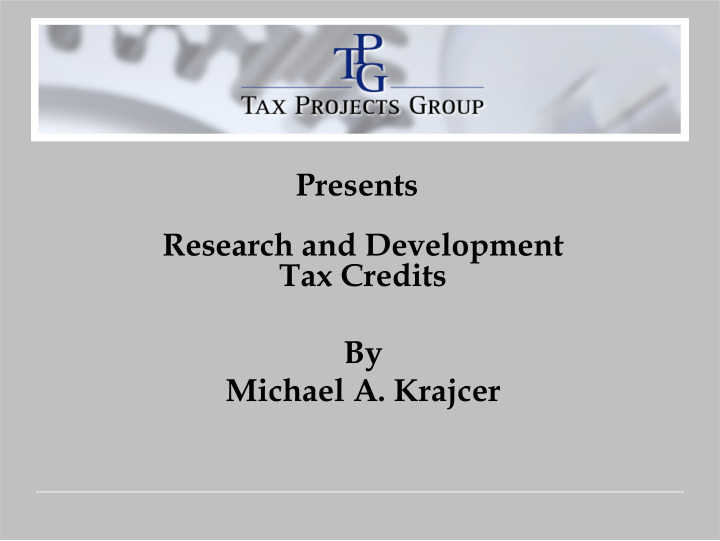



Presents Research and Development Tax Credits By Michael A. Krajcer
Agenda • Introduction • Technical Overview • Defining “R&D” –In the Eyes of the IRS • IRC Section 41 – Credit Requirements • Qualified Research Expenditures • What Activities Qualify as Research and Development • Excluded Activities • Internal Use Software • Conclusion 2 www. T AX P ROJECTS G ROUP.com
Introduction • 4 Partners – former “Big 4” experience • More than 50 years combined tax and consulting experience • Locations in Cleveland, Chicago, New York, Atlanta, Phoenix and Los Angeles 3 www. T AX P ROJECTS G ROUP.com
Michael A. Krajcer - Partner • Firm’s Technical Director • More than 20 years of professional services experience including 13 years with the Internal Revenue Service and 5 years with Ernst & Young • Current clients include companies in the oil & gas, manufacturing, computer software, and financial institution industries • Attorney and CPA, and Adjunct Professor at the Cleveland- Marshall College of Law 4 www. T AX P ROJECTS G ROUP.com
Technical Overview History of the R&D Credit 5 www. T AX P ROJECTS G ROUP.com
Technical Overview History of the R&D Credit • Established in 1981 by the Economic Recovery Tax Act of 1981 as a temporary credit (extended 12 times) • Intended as an incentive for increasing research and development • Provided for a 20 percent credit for qualifying expenditures over a base amount • Included a “discovery” requirement and contemporaneous recordkeeping 6 www. T AX P ROJECTS G ROUP.com
Technical Overview Changes that have Broadened the Scope • Final regulations issued in 2003 removed the “discovery” requirement and relaxed the documentation requirements • Today, many companies now meet the definition of “research and development” simply by trying to stay competitive • Any process of experimentation is acceptable • Extended through December 31, 2007 • Extension of the credit includes a “alternative simplified method” 7 www. T AX P ROJECTS G ROUP.com
Definition of Research & Development In the eyes of the Internal Revenue Service: R&D begins at concept inception and ends at commercial production Research & Development Life Cycle Design Start of Concept or Commercial Idea Production 8 www. T AX P ROJECTS G ROUP.com
IRC Section 41 – Credit Requirements 1. Business Component Test 2. Technical Uncertainty 3. Process of experimentation 4. Scientific Principles 9 www. T AX P ROJECTS G ROUP.com
IRC Section 41 – Credit Requirements Business Component Test: The Development or improvement of a: Software Product Process Technique Formula Invention 10 www. T AX P ROJECTS G ROUP.com
IRC Section 41 – Credit Requirements Business Component Test An improvement needs to be a functional change rather than an aesthetic change Functionality Reliability Quality Cost Reduction 11 www. T AX P ROJECTS G ROUP.com
IRC Section 41 – Credit Requirements Technical Uncertainty • Research activities must be intended to eliminate uncertainty about the capability or method of developing or improving the business component or about its appropriate design 12 www. T AX P ROJECTS G ROUP.com
IRC Section 41 – Credit Requirements Process of Experimentation • A process designed to evaluate one or more alternatives where the capability or method of achieving a result, or its appropriate design, is uncertain and not readily determinable and applicable at the beginning of the research activities 13 www. T AX P ROJECTS G ROUP.com
IRC Section 41 – Credit Requirements Use of Scientific Principles • Process of experimentation must rely fundamentally on the principles of the physical or biological sciences, engineering, or computer science • A taxpayer may use existing principles of these sciences to satisfy the requirements • “Soft” sciences such as humanities, management sciences, social sciences do not meet these requirements. 14 www. T AX P ROJECTS G ROUP.com
Qualified Research Expenditures Contract Supplies WAGES Research 65% Qualified Research Expenditures 15 www. T AX P ROJECTS G ROUP.com
What Qualifies as R&D? • Designing new or improved equipment Developing of electronic monitoring and • and components to be used in control systems and techniques exploration, drilling, and production Developing computer software. This • processes applies to software developed internally, • Developing innovative technologies and as well as to vendor created software that processes for exploration, drilling, is meant for sale or lease completion, and production Developing new or improved injection • • Developing new or improved marshaling techniques service processes Designing new processes to deal with • • Developing more efficient and cost- environmental issues effective subsea interventions • Developing equipment and processes to deal with challenging environments 16 www. T AX P ROJECTS G ROUP.com
Excluded Activities • Research conducted after the beginning of commercial production • Adaptation of an existing business component to a particular customers needs • Reverse engineering 17 www. T AX P ROJECTS G ROUP.com
Internal Use Software • Special Rules exist for software created strictly for internal use (high threshold of innovation test) – Software must be innovative – Development includes significant economic risk – Software is not commercially available 18 www. T AX P ROJECTS G ROUP.com
Conclusion • Questions? 19 www. T AX P ROJECTS G ROUP.com
Recommend
More recommend